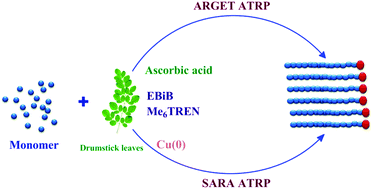Natural catalyst mediated ARGET and SARA ATRP of N-isopropylacrylamide and methyl acrylate†
Abstract
An extract prepared from easily available, inexpensive drumstick leaves (Moringa oleifera) containing natural transition metals in the ppm level was exploited as an efficient catalyst for the well-controlled synthesis of poly(N-isopropylacrylamide) (PNIPAM) and poly(methyl acrylate) (PMA). The use of excess ascorbic acid with a green catalyst greatly enhances the rate of polymerization. This unprecedented green catalyst mediated polymerization was found to resemble ARGET ATRP in which the activators are continuously regenerated by the reducing agents from deactivators. Experimentally, the redox nature of the green catalyst upon addition of ascorbic acid was carefully investigated under different polymerization conditions. The installation of a bromine atom at the omega end of the polymeric chain was confirmed by chain extension and 1H NMR analysis. The mechanistic intricacies of the proposed novel-type catalyst in the polymerization were elucidated by using ICP-OES, XPS, GC-MS, and LSV (linear sweep voltammetry) techniques. This ultra-low level catalyst ATRP technique would thus circumvent the stringent and time consuming post purification step of the polymer synthesis. The polymers produced by this technique may be used for many industrial applications without further purification.


 Please wait while we load your content...
Please wait while we load your content...